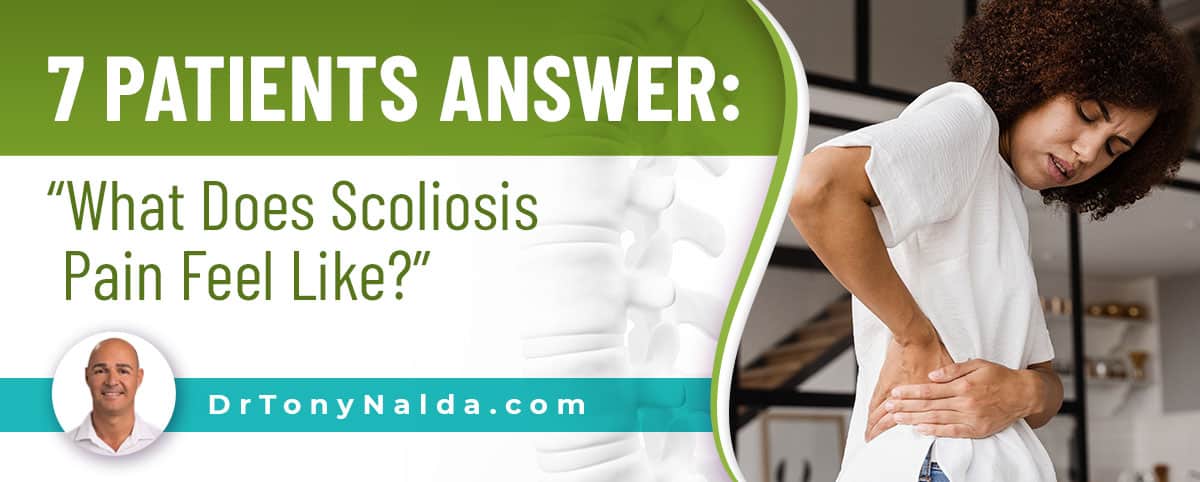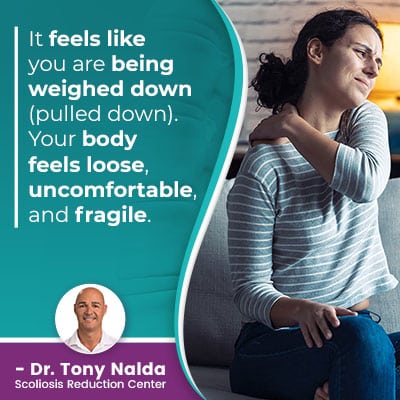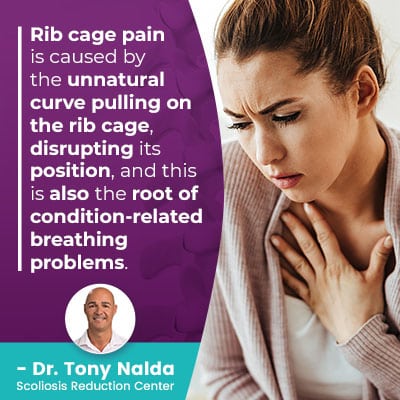7 Patients Answer: "What Does Scoliosis Pain Feel Like?"

Not only are there different severity levels of scoliosis, but there are also different condition types, each with its own unique symptoms, causation, and treatment needs. Patient age is a huge contributing factor when it comes to whether or not a condition is painful; continue reading to find out why, and hear from real patients describing what it feels like to have scoliosis.
Part of the reason scoliosis is such a complex condition to treat is how highly variable it is, ranging from mild to very severe. In addition to severity, patient age, causation, and curvature location will shape each individual’s experience of what their condition feels like, including pain.
To better understand the factors that contribute to whether or not a person’s scoliosis is painful, let’s start with how scoliosis is diagnosed and classified.
Table of Contents
Diagnosing and Classifying Scoliosis
Part of the diagnostic process involves comprehensively assessing scoliosis based on key patient/condition variables to further specify the diagnosis; after all, there are many different kinds of scoliosis and scoliotic curves.
Classifying scoliosis is important not only in terms of streamlining the treatment process but also in shaping the design of effective treatment plans.
The complex and highly-variable nature of scoliosis necessitates a customized treatment approach.
For a person to be diagnosed with scoliosis, certain condition characteristics have to be met; scoliosis involves the development of an unnatural spinal curve with rotation, and the curve has to have a minimum Cobb angle of 10 degrees.
The rotational component is what makes scoliosis a 3-dimensional condition because a scoliotic spine doesn’t just bend unnaturally to the side but also twists from back to front, front to back.
In addition to patient age and condition severity, curvature location and causation are also classification points, but as condition severity and patient age are the largest contributing factors to scoliosis pain, those are the factors we’ll be focusing on for our current purposes.
Condition severity is a key classification point, and an important variable when it comes to scoliosis pain, and this is determined by a patient’s Cobb angle.
Cobb Angle and Condition Severity
A patient’s Cobb angle is a measurement taken during an X-ray that involves drawing intersecting lines from the tops and bottoms of the curve’s most-tilted vertebrae (bones of the spine).
So a patient’s Cobb angle tells me how far out of alignment their spine is, while further classifying conditions based on severity:
- Mild scoliosis: Cobb angle measurement of between 10 and 25 degrees
- Moderate scoliosis: Cobb angle measurement of between 25 and 40 degrees
- Severe scoliosis: Cobb angle measurement of 40+ degrees
- Very-severe scoliosis: Cobb angle measurement of 80+ degrees
Generally speaking, the higher the Cobb angle, the more severe the condition, and the more noticeable its symptoms are likely to be, including pain; however, it’s important to understand that what one patient experiences, another might not, so let’s look at some other variables that shape patient experience.
Patient Age
When it comes to scoliosis pain, in addition to condition severity, patient age is the main variable affecting whether or not a patient’s scoliosis is painful.
While the most prevalent condition type is adolescent idiopathic scoliosis, diagnosed between the ages of 10 and 18, scoliosis affects all ages.
When it comes to scoliosis, patient age is important in two main ways: progression and pain.
Scoliosis is progressive, meaning it’s in its very nature to worsen over time; scoliosis isn’t curable, but it is highly treatable.
It’s growth and development that triggers progression, so children and adolescents who have not yet reached skeletal maturity are at risk for rapid-phase progression, while adults tend to have slower progressive rates because the trigger of growth is removed.
When it comes to pain, while scoliosis can cause different types of pain and issues, the main source of condition-related pain is compression of the spine and its surrounding muscles and nerves.
In young patients who are still growing, the constant lengthening motion of a growing spine counteracts the compressive force of the curve, which is why the adolescent and adult experience of scoliosis pain tends to differ so widely.
So now that we know how scoliosis is diagnosed and classified let’s move on to addressing what it actually feels like to have scoliosis from patients themselves.
What Does it Feel Like to Have Scoliosis?
Remember, what one patient feels another might not, which is why it’s so helpful to hear from actual scoliosis patients on how painful scoliosis can be and what scoliosis pain actually feels like.
 Rebecca P describes her scoliosis pain: “It feels like you are stiff on one side. One side is more curvy than the other, and your legs feel uneven.”
Rebecca P describes her scoliosis pain: “It feels like you are stiff on one side. One side is more curvy than the other, and your legs feel uneven.”
Scoliosis introduces a lot of uneven forces to the body, and that causes one of the main visual scoliosis symptoms: postural deviation involving a disruption to the body’s overall symmetry.
In addition, it’s not just the spine that’s charged with maintaining its natural curves and alignment, but also its surrounding muscles, so as the muscles surrounding the spine try to support the unnatural curve, they are also exposed to uneven forces and can become strained, tight, and sore.
Ariel Y describes her scoliosis pain: “At first, it felt like nothing, but now, it feels painful when doing certain activities. Emotionally, it feels scary, even if you feel no pain. Just knowing you have it and need to fix it is scary.”
This is an important response because it highlights a challenge of treating scoliosis: its progressive nature.
Remember, where a scoliosis is at the time of diagnosis is not indicative of where it will stay. Even patients diagnosed with mild scoliosis, who don’t initially find it painful or disruptive to their daily lives, can end up feeling very differently, which is why proactive treatment to prevent increasing condition severity it so important.
While not every patient with scoliosis will have activity restrictions, there are some forms of exercise and activities that should be approached with caution because they can exacerbate symptoms, cause pain, and/or interfere with treatment.
The psychological pressure of knowing you’re living with a progressive condition can take its toll: waiting for it to get worse, wondering how much worse it will get.
The pressure of wanting to react to a diagnosis in the right way to minimize its effects can be overwhelming; again, why treatment and support are so important.
Baleg D describes his scoliosis pain: “It feels like you are being weighed down (pulled down). Your body feels loose, uncomfortable, and fragile.”
It’s the compression factor and adverse spinal tension that can make a person feel pulled down by their scoliosis, and the body feeling uncomfortable is, again, the result of uneven forces introduced by the condition, not to mention the body’s shifting center of gravity due to the unnatural spinal curve.
In addition, with a variety of spinal conditions, scoliosis included, if the spine’s function is affected, it disrupts its biomechanics and overall health, making it more vulnerable to injury, and the psychological effect of this knowledge can leave patients feeling fragile and hesitant to try new things.
Isabella V describes her scoliosis pain: “It feels like your shoulders are uneven and you are being pulled down to one side. Your back is painful.”
As mentioned, particularly in adolescents, a postural deviation is the main scoliosis symptom, and in many cases, uneven shoulders and hips are the condition’s earliest signs.
The muscles that support the areas of the body, such as the shoulders, that are shifting unnaturally can become strained as they are exposed to uneven wear, and the feeling of being pulled to one side is a result of the unnatural sideways spinal curve.
Back pain can be localized, or radicular pain felt throughout the body, and this is due to compression of the spine and its nerves.
Brianna T describes her scoliosis pain: “Emotionally, it feels like a heavy weight; it makes me scared of what I look like. Physically, it feels like pressure on my rib cage and makes it hard to breathe while working.”
 Too often, the emotional component of living with medical conditions, particularly progressive ones, is overlooked or not prioritized. As you can see from these real-life patient descriptions, emotional pain and fears can be just as debilitating as physical pain.
Too often, the emotional component of living with medical conditions, particularly progressive ones, is overlooked or not prioritized. As you can see from these real-life patient descriptions, emotional pain and fears can be just as debilitating as physical pain.
Adolescents want to fit in with their peers. They want to look the same, walk the same, and scoliosis can make them look and walk differently. That can take a toll on self-esteem and overall happiness, and the fear of how much more they might change can be overwhelming.
Rib cage pain is caused by the unnatural curve pulling on the rib cage, disrupting its position, and this is also the root of condition-related breathing problems.
While more common in severe cases of scoliosis, lung impairment can develop as the rib cage shifts, leaving less space for the lungs to function optimally within: making it difficult to inhale/exhale deeply, particularly during times of physical exertion.
Tina N describes her scoliosis pain: “It feels like lower-left back pressure that gets relief when adjusted.”
A combination of compression and strained muscles causes the feeling of pressure in the back.
In most typical cases of scoliosis, the curve bends to the right, away from the heart, and as the muscles and spine try to counteract that unnatural pull to the right, its effects can be felt on the left side.
Remember, scoliosis can develop anywhere along the spine, so if lower back pain is the most noticeable symptom, this is likely due to the unnatural spinal curve developing in the lower back.
Condition-specific chiropractic care is the keystone of my treatment approach, and I use it not only to provide patients with pain relief but also to impact the condition on a structural level.
Keith R describes his scoliosis pain: “It feels like a tightness in the lower back and a lack of flexibility.”
A common thread through these various descriptions is the feeling of tightness, and once again, this is due to compression, uneven forces, postural deviation, and strained muscles.
While it’s common to feel the majority of back pain in the section of the spine with the unnatural curve, it’s also important to understand that one way the spine can respond to the development of an unnatural spinal curve in one section is to put in a compensatory curve in another.
So a patient with an unnatural thoracic (middle/upper back) curve, can still experience lower back pain, particularly when a compensatory lumbar (lower back) curve develops in an attempt to counteract the unnatural spinal curve above.
A lack of spinal flexibility is a big factor in adult scoliosis because as scoliosis progresses over time, the spine becomes more and more rigid: another benefit of being proactive with treatment.
Spinal rigidity makes it less responsive to treatment, and in fact, with many of my adult scoliosis patients, I have to do some preparatory work to reach a baseline level of spinal flexibility prior to starting the regular course of treatment.
Conclusion
So what does scoliosis pain feel like? As you can see, the answer varies from patient to patient, with some common threads being tightness, pain, and the emotional weight of living with a progressive condition.
The progressive nature of scoliosis is why the best time to start scoliosis treatment is always now.
I don’t want patients to experience the hardships associated with progression, increasing condition severity, escalating symptoms, and the need for more invasive treatment in the future.
Here at the Scoliosis Reduction Center, my main goal of treatment is to impact conditions on every level, structurally and emotionally, and as patients start to see results and feel better, the motivation to move forward with treatment is strong: showing just how treatable scoliosis can be.
Dr. Tony Nalda
DOCTOR OF CHIROPRACTIC
After receiving an undergraduate degree in psychology and his Doctorate of Chiropractic from Life University, Dr. Nalda settled in Celebration, Florida and proceeded to build one of Central Florida’s most successful chiropractic clinics.
His experience with patients suffering from scoliosis, and the confusion and frustration they faced, led him to seek a specialty in scoliosis care. In 2006 he completed his Intensive Care Certification from CLEAR Institute, a leading scoliosis educational and certification center.
About Dr. Tony Nalda
 Ready to explore scoliosis treatment? Contact Us Now
Ready to explore scoliosis treatment? Contact Us Now





